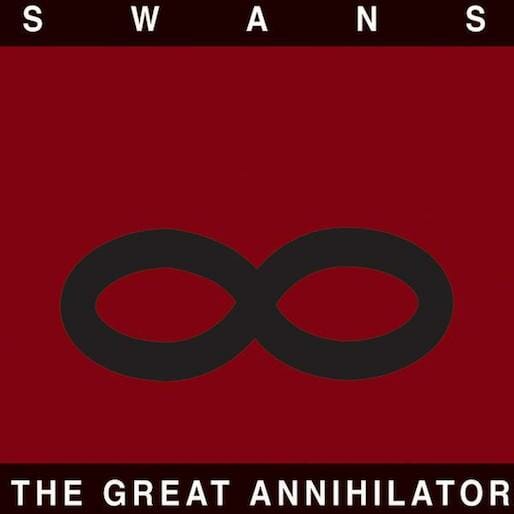In 1995, Swans were a band in transition. Having maintained an album-a-year pace for most of their existence, they had taken an unusually long three years to release The Great Annihilator. By that point, Michael Gira and his constantly shifting lineup of bandmates had already laid the groundwork for a particularly caustic brand of industrial and noise music, mutating through No Wave, avant garde minimalism and surprisingly approachable experimental rock. But by the mid-’90s, Gira was restless and ready to move on, only two years away from disbanding the act altogether (albeit temporarily). The Great Annihilator would be the penultimate statement for that era of this project.
Twenty-two years later, Gira admits in the press release for the album’s remastered reissue that he was never satisfied with the original’s murky, reverb-drenched mix. A lack of time and money had forced them to issue something that wasn’t quite what they wanted. After Bill Rieflin, drummer for the album, discovered the long-lost master tapes in his archive, Gira finally got his second chance at perfecting an LP that most fans already consider to be among the band’s very best. The differences are immediate and obvious.
Opener “In” enters with a roaring immensity the original lacked, with ominous howls, crashing percussion, and droning atmospherics swirling around oscillating, wordless vocals. Similarly, the cleaned up funeral parlor organs and solemn acoustic guitar strikes of “She Lives!” add an unsettling depth and clarity to Gira’s sarcastic taunts to a woman losing her mind, recreating the uneasy calm of a humid summer sky right before a thunder peal rips it in half. The mixing differences are most noticeable on the more layered tracks, as the tiny details—a hidden synth line here or a bobbing bass countermelody there—now rise to the surface. None sound better than “Killing for Company,” a haunted serial killer ballad that sounds utterly transcendent when cleaned up, its soft keyboards and sickly sweet backing vocals wrapped around Gira’s eerily indifferent menthol croon.
What hasn’t changed is how dazzling the album is in its eclecticism. The band never made an album that pulled together all of its respective eras quite so effectively. It’s striking just how approachable some of these songs are, especially compared to the increasingly expansive material Gira has made since resurrecting Swans in 2010. Here, the grinding layers of guitar distortion on “Celebrity Lifestyle” wouldn’t fallen too far away from the stuff coming out of Seattle a few years earlier, just as the ethereal layers of synths and soaring melodies of “My Buried Child” make for arguably the most pop-oriented track the band has ever recorded. The tracks with the now-exiled Jarboe on vocals could very well be classified as New Age today, with the hypnotic piano and chant-like vocals of “Warm” sounding positively Enya-esque. But the band’s antisocial past is never far away. The unnerving call-and-response of “I Am the Sun,” with its eruptions of guitar feedback and machine-like drumming, is a murder cult singalong that ranks among the most brutal tracks in their misanthropic catalog. Only Gira could make a recitation of the lyric “I love everyone” come off like a threat.
Even more surprising is the accompanying reissue of Drainland, Gira’s largely forgotten debut solo release from the same year. Recorded with only Jarboe and Rieflin serving as the backing band, the stripped-down arrangements of guitars, keyboards and bells proved that Gira could reduce his sound into an even more elemental form and not lose any of its genuine menace. In fact, most of the tracks here probably could have been slipped onto The Great Annihilator without much notice, though Gira’s writing is even more obsessed with body horror, made extra unsettling on tracks where he sings in an oddly pinched voice that only adds to the unease. “Fan Letter” builds upon samples of canned laughter with treacly keyboard lines and carnival drums to tell the story of—you guessed it—a madness-induced murder. There are corpses floating (literally) through the gentle balladry of “Where Does Your Body Begin?” and “Your Naked Body,” tracks whose entrancing surface beauty creates an uncomfortable contrast with the underlying sentiments. Between the two albums, you have the blueprint for nearly everything Gira would do over the next decade with both Angels of Light and the reunited Swans.
The only real criticism that could be leveled at these releases is that aside from one bonus track (a live version of “I Am the Sun”), there is no unreleased or archival material included. Of course, given Gira’s prolific working habits, it’s hard to quibble when only the most obsessive Swans fans have tracked down everything the band has done over the past 35 years. Today, Gira is the rarest of all songwriters, an artist making increasingly ambitious music that not only measures up against his seminal work but in many ways surpasses it. And as much as The Great Annihilator and Drainland capture the end of the first half of his evolution, in many ways they also open the second half where he was about to reinvent himself more dramatically than ever before. Both records sound better, and more relevant, now than they did on the day of their release.
